中考英语语法复习-冠词 教学 课件
- 格式:pptx
- 大小:668.62 KB
- 文档页数:21
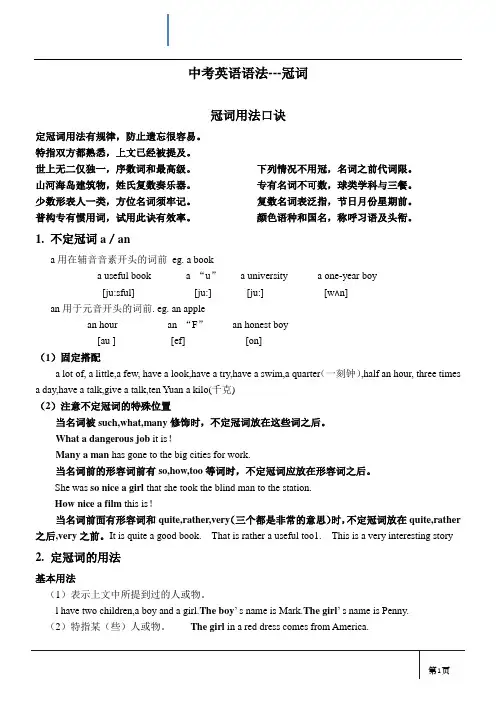
中考英语语法---冠词冠词用法口诀定冠词用法有规律,防止遗忘很容易。
特指双方都熟悉,上文已经被提及。
世上无二仅独一,序数词和最高级。
山河海岛建筑物,姓氏复数奏乐器。
少数形表人一类,方位名词须牢记。
普构专有惯用词,试用此诀有效率。
下列情况不用冠,名词之前代词限。
专有名词不可数,球类学科与三餐。
复数名词表泛指,节日月份星期前。
颜色语种和国名,称呼习语及头衔。
1.不定冠词a/ana用在辅音音素开头的词前eg. a booka useful book a “u” a university a one-year boy[ju:sful] [ju:] [ju:] [wʌn]an用于元音开头的词前. eg. an applean hour an “F”an honest boy[au ] [ef] [on](1)固定搭配a lot of, a little,a few, have a look,have a try,have a swim,a quarter(一刻钟),half an hour, three times a day,have a talk,give a talk,ten Yuan a kilo(千克)(2)注意不定冠词的特殊位置当名词被such,what,many修饰时,不定冠词放在这些词之后。
What a dangerous job it is!Many a man has gone to the big cities for work.当名词前的形容词前有so,how,too等词时,不定冠词应放在形容词之后。
She was so nice a girl that she took the blind man to the station.How nice a film this is!当名词前面有形容词和quite,rather,very(三个都是非常的意思)时,不定冠词放在quite,rather 之后,very之前。


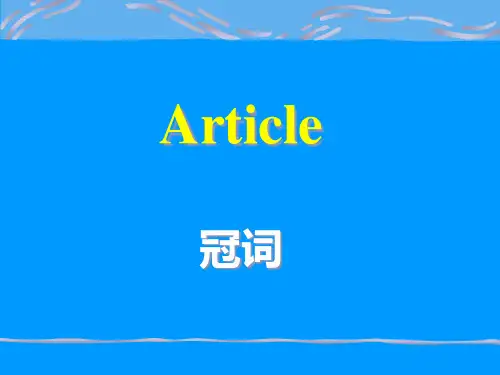
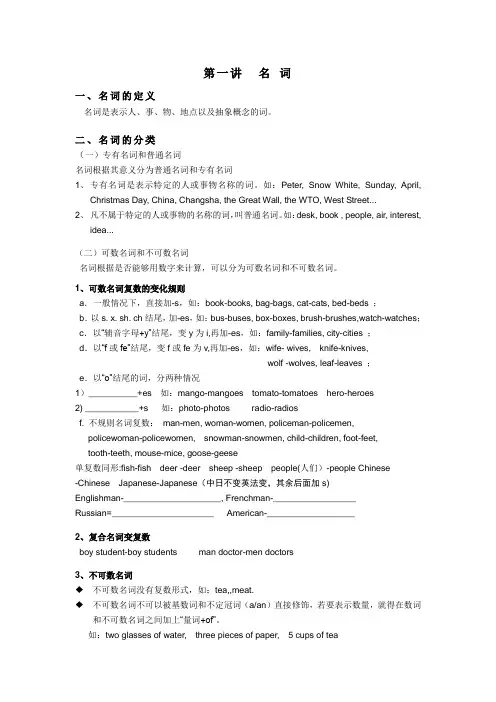
第一讲名词一、名词的定义名词是表示人、事、物、地点以及抽象概念的词。
二、名词的分类(一)专有名词和普通名词名词根据其意义分为普通名词和专有名词1、专有名词是表示特定的人或事物名称的词。
如:Peter, Snow White, Sunday, April,Christmas Day, China, Changsha, the Great Wall, the WTO, West Street...2、凡不属于特定的人或事物的名称的词,叫普通名词。
如:desk, book , people, air, interest,idea...(二)可数名词和不可数名词名词根据是否能够用数字来计算,可以分为可数名词和不可数名词。
1、可数名词复数的变化规则a.一般情况下,直接加-s,如:book-books, bag-bags, cat-cats, bed-beds ;b.以s. x. sh. ch结尾,加-es,如:bus-buses, box-boxes, brush-brushes,watch-watches;c.以“辅音字母+y”结尾,变y为i,再加-es,如:family-families, city-cities ;d.以“f或fe”结尾,变f或fe为v,再加-es,如:wife- wives, knife-knives,wolf -wolves, leaf-leaves ;e.以“o”结尾的词,分两种情况1)__________+es 如:mango-mangoes tomato-tomatoes hero-heroes2) ___________+s 如:photo-photos radio-radiosf. 不规则名词复数:man-men, woman-women, policeman-policemen,policewoman-policewomen, snowman-snowmen, child-children, foot-feet,tooth-teeth, mouse-mice, goose-geese单复数同形:fish-fish deer -deer sheep -sheep people(人们)-people Chinese-Chinese Japanese-Japanese(中日不变英法变,其余后面加s)Englishman-____________________, Frenchman-_________________Russian=_____________________ American-__________________2、复合名词变复数boy student-boy students man doctor-men doctors3、不可数名词◆不可数名词没有复数形式,如:tea,,meat.◆不可数名词不可以被基数词和不定冠词(a/an)直接修饰,若要表示数量,就得在数词和不可数名词之间加上“量词+of”。
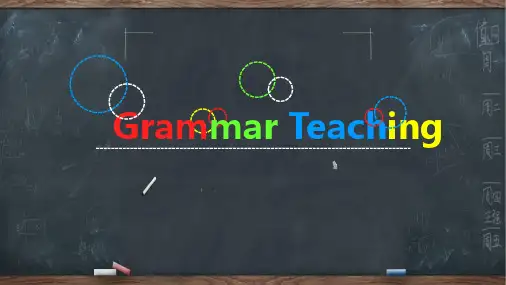
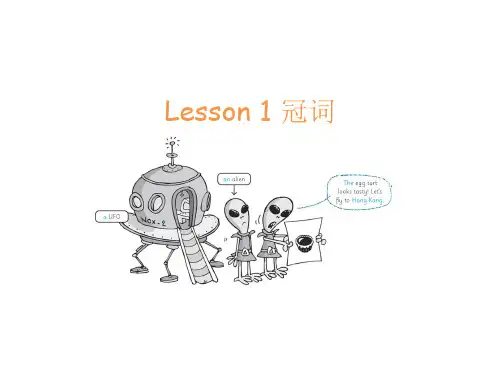



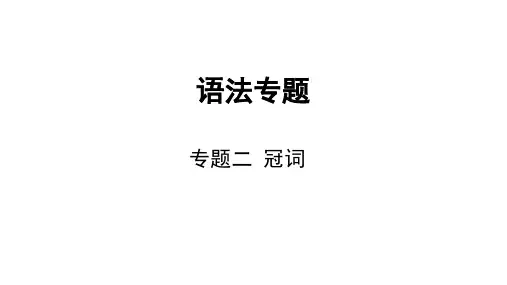
新初三英语衔接--冠词概念:冠词是置于名词之前,说明名词所表示的人或事物的一种虚词,它不能离开名词而单独存在。
冠词有两种,一种是定冠词(the),一种是不定冠词(a、an)。
考点一:不定冠词a/an的用法1、在叙述时第一次提到某人或某物前。
This ia a book.2、表示泛指“一(个)或一类”(基本用法),如:A plane is a machine. (表一类) He is an office worker. (表一个)3、用于序数词前,表示“又一”。
He failed twice, but he still wanted to try a third time.4、用在表示价格、速度、比率等名词前,表示“每一”。
three times a day 一天三次; 50 yuan a kilo 50元一公斤;ten miles an hour一小时10英里5、固定搭配:have a rest/break , quite a few , go for a walk, make a telephone call…【中考真题再现】( )1.—What are you going to be when you grow up?--teacher like you.A. AB. AnC. TheD. /( )2.---Why do you like Jack?---Because he is honest boy. A. a B. an C. the D. \ ( )3. –I know you have seen the film. Why did you buy a ticket once more?--I want to see it .A. the second timeB. a second timeC. twiceD. two times( )4. Let’s have break; I want to make telephone call.A. a; aB. a; theC. the ; aD. the ; the考点二:不定冠词a/an 的区别观察下表总结a/an的区别:【中考真题再现】( )1.---What do you want to be in the future, Nick?--- I want to be pilot. It is exciting job.A. a; aB. a; anC. the, anD. a; the( )2. As we know, England is European country and Singapore is -------Asian country.A. an; anB. an; aC. a; aD. a; an考点三:定冠词the的用法1、特指的人或事之前。
第一课时名词、冠词1.名词名词是历年中考的重要考点,常常出现在完形填空、语法填空题型中。
名词部分主要考查: ①名词的数(可数与不可数、单数与复数) ①名词和冠词的搭配①抽象名词的具体化 ①名词的词性变化①名词的词义辨析1.(1)规则变化①以-o 结尾的下列名词要加-es :“黑人英雄爱吃土豆、西红柿”,即Negroes ,heroes, potatoes ,tomatoes 。
①以-f 或-fe 结尾的名词需要把f 或fe 去掉,加-ves :“为了自己活命,小偷和他的妻子手里拿着刀子和树叶站在架子上,把狼劈成两半”,即selves ,lives ,thieves ,wives ,knives ,leaves ,shelves ,wolves ,halves 。
(2)不规则变化但是没有起作用的。
1.-’s ’s 或’;表示共同的所有关系时,只在最后一个名词后加-’s 或’。
①表示店铺、办公室或某人的家时,名词所有格后被修饰的名词一般省略。
Tom’s and Jim’s rooms 汤姆和吉姆(各自)的房间Tom and Jim’s room 汤姆和吉姆(共同)的房间at the barber’s 在理发店2.of 所有格:无生命的事物的名词通常用of 所有格表示所有关系;名词短语或有定语修饰的有生命的名词也常用of 所有格。
the content of the novel 小说的内容the name of the girl over there 那边那位女孩的名字3.双重所有格:“名词+of +名词所有格”或“名词+of +名词性物主代词”。
a play of Shakespeare’s 莎士比亚的一个戏剧a photo of mine我的一张照片随堂练习考点1名词辨析①.单项选择1.—We can always find something good in a bad if we look for it.—It’s so true. Let’s make full use of what comes.A.situationB.directionC.instructionpetition【答案】A本题考查名词词义辨析。